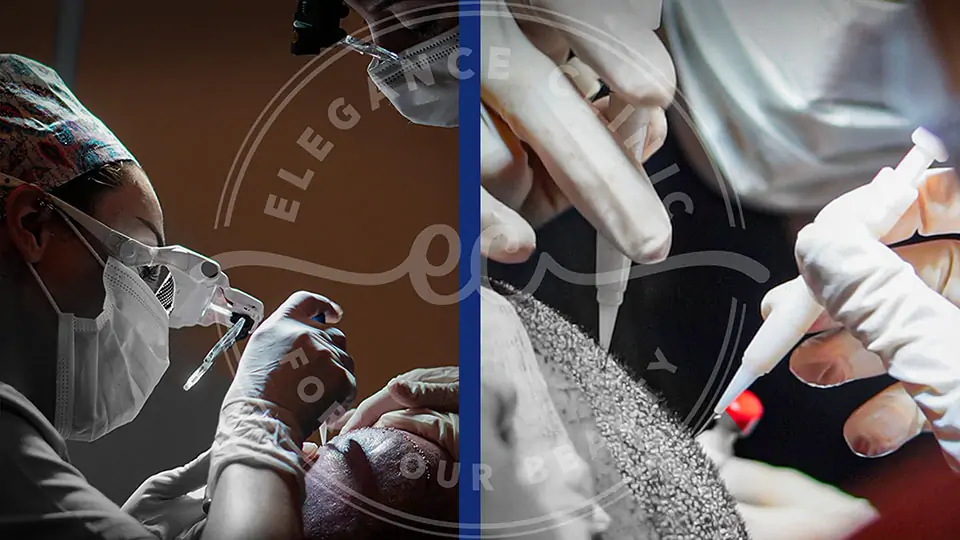DHI Hair Transplant
What Is DHI Hair Transplant? The Latest Technology for a Natural and Dense Look
Hair loss is a significant problem today that causes aesthetic concerns in both men and women. Genetic factors, stress, hormonal changes, or environmental influences can lead to hair loss, which over time negatively affects self-confidence as well. At this point, hair transplant technologies make it possible to restore lost hair in a natural and permanent way. One of the most remarkable of these technologies is the DHI hair transplant method.
DHI (Direct Hair Implantation), or “Direct Hair Transplant,” has emerged in recent years as one of the most modern and effective techniques in the field of hair transplantation. It is an ideal method especially for those seeking a dense and natural hair appearance.

How Is DHI Hair Transplant Performed?
In DHI hair transplantation, hair follicles are taken from the donor area (usually the nape) with the help of micro-motor devices and implanted directly into the target area using a special Choi implanter pen. This method minimizes the time grafts spend outside the body, keeping follicles more vital and increasing their survival rate.
The most important feature of the DHI method is that channel opening and follicle placement are performed simultaneously in a single step. This ensures a faster process and minimizes tissue damage.
Who Is Suitable for DHI Hair Transplant?
DHI hair transplant is particularly suitable for individuals who want to densify the frontal hairline, have limited thinning, or desire a denser appearance. Since it can also be performed without shaving, it is frequently preferred by women.
Ideal candidate profile:
- Individuals over 18 years old whose hair loss process has mostly stabilized
- Those who have a sufficient number of healthy follicles in the donor area
- Those who want a more natural and dense hair appearance
- Individuals without any health problems preventing the procedure
Advantages of DHI Hair Transplant
DHI hair transplantation offers several advantages over other methods. Here are the key benefits:
- No shaving required: A great convenience, especially for female patients.
- Natural hairline: Thanks to the Choi pen, follicles can be placed at the desired angle and direction.
- High density: More grafts can be placed in a smaller area, providing a fuller look.
- Faster recovery: With minimal tissue damage, crusting and healing occur in a shorter period.
- Higher follicle survival rate.
What Is the Difference Between DHI and FUE?
Although both FUE (Follicular Unit Extraction) and DHI are micro-surgical hair transplant methods, they differ in application techniques.
| Feature | FUE | DHI |
|---|---|---|
| Channel Opening | Performed as a separate step | Not required |
| Graft Placement | Done with forceps | Directly with Choi pen |
| Shaving | Required | Not required (optional) |
| Density | Medium-High | High |
| Recovery Time | Average | Faster |
What Is the DHI Hair Transplant Process?
- Consultation and Analysis: Your hair structure, level of loss, and donor area are examined to create the most suitable plan for you.
- Surgery Day: The procedure is performed under local anesthesia without pain. Grafts are harvested from the donor area and implanted directly into the bald area using the Choi pen.
- First 10 Days: Crusting and mild itching may occur. Special care products are used during this period.
- Shock Shedding: Temporary hair loss may occur in the first 1–2 months. This is a normal and temporary process.
- Permanent Results: New hair begins to grow from the 3rd month. The final look becomes clear within 12–15 months.
What Should Be Considered After DHI Hair Transplant?
- The transplanted area should not be touched and must be protected from trauma during the first week.
- Sleep with your head elevated and on your back.
- Hair washing should be performed as instructed by the clinic, using the recommended products.
- Avoid heavy exercise, sauna, and steam baths for the first 2–3 weeks.
- Medications prescribed by the doctor should be taken regularly.
Conclusion: A Natural and Impressive Look Awaits You with DHI Hair Transplant
If you want to regain your hair naturally and feel better both aesthetically and psychologically, DHI hair transplant may be the right method for you. With denser results, more control, and faster recovery, this technology has made hair transplantation more effective and comfortable.
Remember: Just as important as the technique itself is choosing the right team and clinic, which are among the most crucial factors determining success. While investing in your hair and self-confidence, don’t neglect these details.
Frequently Asked Questions
1. Is DHI hair transplant painful?
No. DHI hair transplant is performed under local anesthesia, and no pain is felt during the procedure. Mild sensitivity may be experienced afterward.
2. Is shaving mandatory for DHI?
No. The DHI method can also be performed without shaving, making it particularly popular among women.
3. When does new hair start to grow after DHI?
In the first 2 months, shock shedding occurs. Permanent hair typically starts to grow from the 3rd month, and final results are achieved within 12–15 months.
4. Is DHI hair transplant permanent?
Yes. Hair follicles taken from the donor area are genetically resistant to hair loss and adapt permanently to their new location.
5. Can I exercise after DHI hair transplant?
It is recommended to avoid heavy exercise, sauna, and steam baths for the first 2–3 weeks. Later, you may return to your routines following your doctor’s advice.
